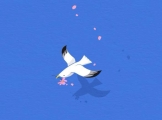|
我一直在尝试使用 texture2d_array 在 Metal 中应用实时过滤器。但我没有得到正确的结果。
我正在创建这样的纹理数组,
代码:Class MetalTextureArray.
class MetalTextureArray {
private(set) var arrayTexture: MTLTexture
private var width: Int
private var height: Int
init(_ width: Int, _ height: Int, _ arrayLength: Int, _ device: MTLDevice) {
self.width = width
self.height = height
let textureDescriptor = MTLTextureDescriptor()
textureDescriptor.textureType = .type2DArray
textureDescriptor.pixelFormat = .bgra8Unorm
textureDescriptor.width = width
textureDescriptor.height = height
textureDescriptor.arrayLength = arrayLength
arrayTexture = device.makeTexture(descriptor: textureDescriptor)
}
func append(_ texture: MTLTexture) -> Bool {
if let bytes = texture.buffer?.contents() {
let region = MTLRegion(origin: MTLOrigin(x: 0, y: 0, z: 0), size: MTLSize(width: width, height: height, depth: 1))
arrayTexture.replace(region: region, mipmapLevel: 0, withBytes: bytes, bytesPerRow: texture.bufferBytesPerRow)
return true
}
return false
}
}
我像这样将这个纹理编码到 renderEncoder 中,
代码:
let textureArray = MetalTextureArray.init(firstTexture!.width, firstTexture!.height, colorTextures.count, device)
_ = textureArray.append(colorTextures[0].texture)
_ = textureArray.append(colorTextures[1].texture)
_ = textureArray.append(colorTextures[2].texture)
_ = textureArray.append(colorTextures[3].texture)
_ = textureArray.append(colorTextures[4].texture)
renderEncoder.setFragmentTexture(textureArray.arrayTexture, at: 1)
最后我像这样在片段着色器中访问 texture2d_array,
代码:
struct RasterizerData {
float4 clipSpacePosition [[position]];
float2 textureCoordinate;
};
multipleShader(RasterizerData in [[stage_in]],
texture2d<half> colorTexture [[ texture(0) ]],
texture2d_array<half> texture2D [[ texture(1) ]])
{
constexpr sampler textureSampler (mag_filter::linear,
min_filter::linear,
s_address::repeat,
t_address::repeat,
r_address::repeat);
// Sample the texture and return the color to colorSample
half4 colorSample = colorTexture.sample (textureSampler, in.textureCoordinate);
float4 outputColor;
half red = texture2D.sample(textureSampler, in.textureCoordinate, 2).r;
half green = texture2D.sample(textureSampler, in.textureCoordinate, 2).g;
half blue = texture2D.sample(textureSampler, in.textureCoordinate, 2).b;
outputColor = float4(colorSample.r * red, colorSample.g * green, colorSample.b * blue, colorSample.a);
// We return the color of the texture
return outputColor;
}
我添加到纹理数组的纹理是从大小为 256 * 1 的 acv 曲线文件中提取的纹理。
在这段代码中 half red = texture2D.sample(textureSampler, in.textureCoordinate, 2).r; 我把最后一个参数设为 2 因为我认为它是纹理的索引访问。但我不知道这是什么意思。
但是在完成所有这些之后,我得到了黑屏。即使我有其他片段着色器,它们都工作正常。但是对于这个片段着色器,我得到了黑屏。我认为对于这段代码 half blue = texture2D.sample(textureSampler, in.textureCoordinate, 2).b 我得到所有红色、绿色和蓝色的 0值(value)观。
编辑 1:
按照建议,我使用 blitcommandEncoder 复制纹理,但仍然没有结果。
我的代码放在这里,
我的 MetalTextureArray 类进行了修改。
方法 append 是这样的。
func append(_ texture: MTLTexture) -> Bool {
self.blitCommandEncoder.copy(from: texture, sourceSlice: 0, sourceLevel: 0, sourceOrigin: MTLOrigin(x: 0, y: 0, z: 0), sourceSize: MTLSize(width: texture.width, height: texture.height, depth: 1), to: self.arrayTexture, destinationSlice: count, destinationLevel: 0, destinationOrigin: MTLOrigin(x: 0, y: 0, z: 0))
count += 1
return true
}
我像这样添加纹理
let textureArray = MetalTextureArray.init(256, 1, colorTextures.count, device, blitCommandEncoder: blitcommandEncoder)
for (index, filter) in colorTextures!.enumerated() {
_ = textureArray.append(colorTextures[index].texture)
}
renderEncoder.setFragmentTexture(textureArray.arrayTexture, at: 1)
我的着色器代码是这样的
multipleShader(RasterizerData in [[stage_in]],
texture2d<half> colorTexture [[ texture(0) ]],
texture2d_array<float> textureArray [[texture(1)]],
const device struct SliceDataSource &sliceData [[ buffer(2) ]])
{
constexpr sampler textureSampler (mag_filter::linear,
min_filter::linear);
// Sample the texture and return the color to colorSample
half4 colorSample = colorTexture.sample (textureSampler, in.textureCoordinate);
float4 outputColor = float4(0,0,0,0);
int slice = 1;
float red = textureArray.sample(textureSampler, in.textureCoordinate, slice).r;
float blue = textureArray.sample(textureSampler, in.textureCoordinate, slice).b;
float green = textureArray.sample(textureSampler, in.textureCoordinate, slice).g;
outputColor = float4(colorSample.r * red, colorSample.g * green, colorSample.b * blue, colorSample.a);
// We return the color of the texture
return outputColor;
}
我还是黑屏。
方法中textureArray.sample(textureSampler, in.textureCoordinate, slice);第三个参数是什么。我认为它是一个索引,我给出了一些随机索引来获取随机纹理。对吗?
编辑 2:
我终于能够实现该建议,并且在实现另一个编码器之前使用 endEncoding 方法得到了结果,并且我得到了带有 ACV 负过滤器的以下屏幕。
 . .
谁能推荐我。
谢谢。
Best Answer-推荐答案
纹理数组和纹理数组是有区别的。在我看来,您只需要一系列纹理。在这种情况下,你不应该使用 texture2d_array;你应该使用 array, 5> texture_array [[texture(1)]].
在应用程序代码中,您可以使用多次调用 setFragmentTexture() 将纹理分配给顺序索引,也可以使用 setFragmentTextures() 分配一堆一次将纹理添加到一系列索引。
在着色器代码中,您可以使用数组下标语法来引用数组中的各个纹理(例如 texture_array[2])。
如果您确实想使用数组纹理,那么您可能需要更改您的 append() 方法。首先,如果 texture 参数不是用 MTLBuffer 的 makeTexture(descriptor ffset:bytesPerRow ffset:bytesPerRow 方法创建的,那么 texture .buffer 将始终为 nil。也就是说,如果纹理最初是从缓冲区创建的,则它们只有关联的缓冲区。要从纹理复制到纹理,您应该使用 blit 命令编码器及其 copy(from:sourceSlice:sourceLevel:sourceOrigin:sourceSize:to:destinationSlice:destinationLevel:destinationOrigin 方法。
其次,如果要替换数组纹理的特定切片(数组元素)的纹理数据,则需要将该切片索引作为参数传递给 replace() 方法.为此,您需要使用 replace(region:mipmapLevel:slice:withBytes:bytesPerRow:bytesPerImage 方法,而不是 replace(region:mipmapLevel:withBytes:bytesPerRow 就像你目前正在做的那样。您当前的代码只是一遍又一遍地替换第一个切片(假设源纹理确实与缓冲区相关联)。
关于ios - 如何在 Metal 中使用 texture2d_array 数组?,我们在Stack Overflow上找到一个类似的问题:
https://stackoverflow.com/questions/46094672/
|  客服电话
客服电话
 APP下载
APP下载

 官方微信
官方微信

















 ffset:bytesPerRow
ffset:bytesPerRow

